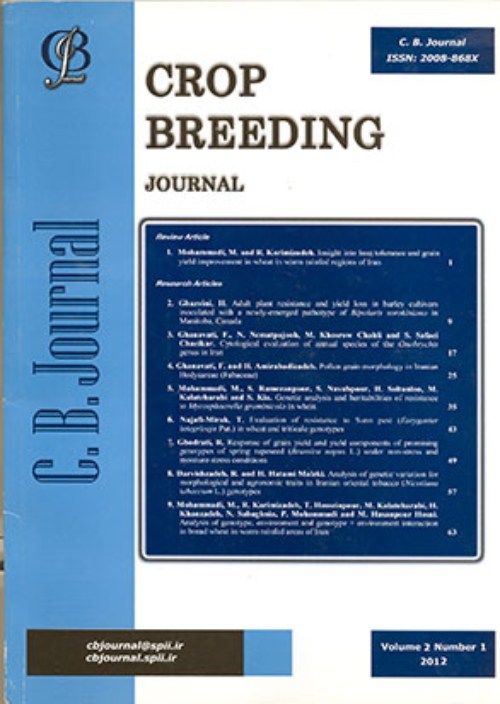Dissection of genotype × environment interaction and assessment of adaptability and grain yield stability of spring bread wheat genotypes
Author(s):
Article Type:
Research/Original Article (دارای رتبه معتبر)
Abstract:
Additive main effects and multiplicative interactions (AMMI) and genotype (G) main effect plus genotype × environment interaction (GEI) GGE biplot models were used to dissect GEI interaction and to assess adaptability of 26 elite bread wheat lines. A multi environment trial was conducted using 26 elite bread wheat lines along with two check cultivars of Chamran and Chamran-2 in 2014-15 and 2015-16 cropping seasons across six testing sites including; Darab (DAR), Dezful (DEZ), Ahvaz (AHV), Khorramabad (KHR), Zabol (ZAB) and Iranshahr (ISH). The sites are representative of the major irrigated wheat production agro-ecologies in southern warm and dry zone of Iran. In each year, the trials at DAR, DEZ and KHR were grown under normally irrigated conditions while trials at AHV, ZAB and ISH were grown under terminal drought stress conditions. Mixed model analysis using Restricted Maximum Likelihood (REML) method showed significant differences among spring bread wheat genotypes for grain yield in all environments. The highest and lowest BLUE means was observed at KHR15 and ZAB15, respectively. Compared to irrigated environments, genotypes showed 35.4% losses, in average, of grain yield under terminal drought stress environments. Combined analysis of variance showed that genotype × environment interaction (GEI) accounted for 9.4% of the total sum of squares. Significant GEI suggests variability in performance of bread wheat genotypes across environments. Partitioning of GEI through AMMI analysis showed that axes IPCA1, IPCA2, and IPCA3 were highly significant (P>0.01) and explained 33%, 22%, and 13% of the GE sum of squares, respectively. The polygon view of the GGE biplot grouped environments into three sectors. AMMI method and GGE biplot showed that G5 had the highest grain yield stability. G5 and G15 were generally better adapted to terminal drought stress environments (AHV14, AHV15, ISH14, ISH15, ZAB14 and ZAB15), while G28 and G8 were more adapted to irrigated environment conditions. AMMI and GGE biplot methods separated the western and southwest regions from the south and southeast test locations for identifying superior adapted spring bread wheat genotypes. Results showed that geographical location had greater impact than the effect of moisture management on the grouping of genotypes. The specific adaptation strategy is suggested for identifying adapted spring bread wheat cultivars with high grain yield and yield stability for these target environments.
Keywords:
Language:
English
Published:
Crop Breeding Journal, Volume:11 Issue: 2, Winter-Spring 2021
Pages:
11 to 24
https://www.magiran.com/p2514776
سامانه نویسندگان
مقالات دیگری از این نویسنده (گان)
-
Bread wheat genotypes selection for delay planting adaptation in the north of Khuzestan using stress sensitivity index (SSI)
*, Mohsen Esmaeilzadeh Moghadam
Journal of cereal Biotechnology and biochemistry, -
Identification of superior bread wheat genotypes using composite indices for cultivation in warm regions
Alireza Askari Kalestani *, , Hassan Zali, Mohsen Esmaeilzadeh Moghadam
Plant Production, -
Stability Analysis of Bread Wheat (Triticum aestivum L.) Genotypes by the Genotype × Genotype-Environment Biplot
Mohsen Esmaeilzadeh Moghadam, Manoochehr Dastfal, , Seyyed Bahram Anderzian Anderzian, Manoochehr Sayyahfar, Khaled Miri, Shirali Koohkan, Alireza Askari Kalestani*
Journal of Crop Breeding, -
Dissection of genotype × environment interaction and yield stability analysis in durum wheat using SHMM and GGE biplot models
Tohid Najafi Mirak, Manoochehr Dastfal, Manoochehr Sayyahfar, Hossein Farzadi, Shahryar Sasani, Hassan Zali *
Plant Production,




